Environmentalism chapter 21 - Alternative stress medicine
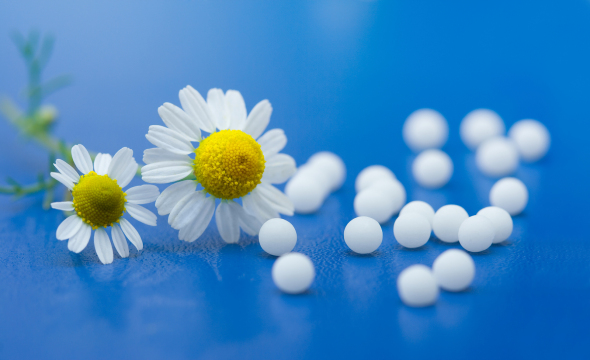
Mother Nature (sometimes known as Mother Earth) is a common personification of nature that focuses on the life-giving and nurturing aspects of nature by embodying it in the form of the mother. We the Homo sapiens were the third dwellers on the planet with Mother Nature being the first occupant that has thrived through many living organisms of which the small cellular living algae was the first living creature “or” plant to evolve upon earth but not formally “established” to this very day as scientific factual evidence.
Botanical species came first in the way of living organisms, then the species of mammals, and non-mammals then of course the human being the last to evolve with no actual scientific proof of how humans actually really evolved. It is stated but never has been actually proven that some 2.3 million years ago humans “could” of evolved from Chimpanzees however with Chimpanzees now set in stone with no further evidence of “evolution change” then this we cannot specify whether humans evolved from “chimps” or not although they share some 97/8% of our DNA structure.
The first fossils of macroscopic land plants have been found in the Middle Silurian of Ireland. They are about 425 million years old. They consist of small bifurcations some centimetres in size. Only in the very last part of the Silurian fossils of land-plants become more common and also more complete. The best known plant from that time is called Cooksonia. It is named after Ms Isabel Cookson, who occupied herself with intensive collecting and describing plant fossils.
The little plant looked very simple with a stem which bifurcated a couple of times topped with small spheres in which the spores were formed. Thus sporangia being formed that had no leave’s, no flowers, no seeds and roots. They most likely had horizontal growing stems, connected with the soil by root hairs that took the function of roots. But this is not sure for fossils proving this has yet to be fully established and maybe never will unless more remains are unearthed. During many millions of years it was mainly this kind of plants that grew on humid places on the land.
So what I am trying to explain is that our botanical species that being the first ever earth dweller we must take as the most important evolution of living known species to date. Plants have always been a natural source of non-potent to powerful forms of medicine, yet still we are killing our botanical species of by the day in the vast swathes of forests that reside in the America’s, and mainly Asia.
We live a very hectic and intense lifestyle and yet still remain on synthetic pharmaceuticals or fake animal parts that being users in Asia mainly for the relief of an array of illness and symptoms such as the common cold, migraine, anxiety, aphrodisiacs, or influenza (antibiotics - DO NOT cure influenza), viral infections, diabetes to blood disorders, hypertension to oedema and tachycardia and many more illness to complaints.
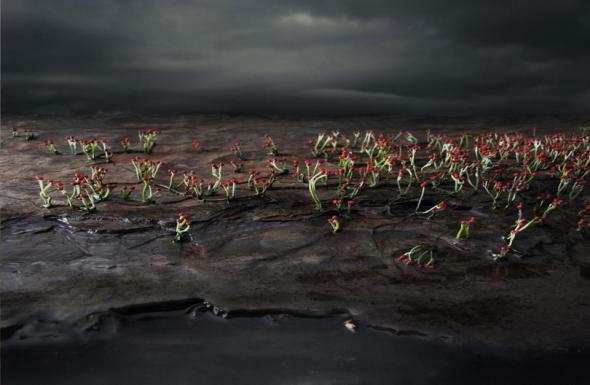
Cooksonia - Located in Ireland over 400 million years ago is said to be the first recorded plant on earth along with mosses and lichens
STRESS though is a number on factor within our life and is not just harming our own health, but others around us too along with harming the environment through negligence chaotic out of control thinking. I have listed below a number of plants that you may be familiar with or may not that can and have been proven time again to help relieve just stress plus other ailments however STRESS or anxiety is the number one subject within this botanical document that I wish to narrate on.
Stress is defined as an organism’s total response to an environmental condition or stimulus, also known as a stressor. Stress typically describes a negative condition that can have an impact on an organism’s mental and physical well-being. There are many “signals” to stress or anxiety attacks to feeling (anxious)
How does stress (interfere with our bodies complex organs?)
Brain
The brain plays a critical role in the body’s perception of and response to stress. However, pinpointing exactly which regions of the brain are responsible for particular aspects of a stress response is difficult and often unclear. Understanding that the brain works in more of a network-like fashion carrying information about a stressful situation across regions of the brain (from cortical sensory areas to more basal structures and vice versa) can help explain how stress and its negative consequences are heavily rooted in neural communication dysfunction. In spite of this, several important brain structures implicated in playing key roles in stress response pathways are described below.
Human brain (hypothalamus=red, amygdala=green, hippocampus/fornix=blue, pons=gold, pituitary gland=pink)
Hypothalamus
The hypothalamus is a small portion of the brain located below the thalamus and above the brainstem. One of its most important functions is to help link together the body’s nervous and endocrine systems. This structure has many bidirectional neural inputs and outputs from and to various other brain regions. These connections help regulate the hypothalamus’ ability to secrete hormones into the body’s blood stream, having far-reaching and long-lasting effects on physiological processes such as metabolism. During a stress response, the hypothalamus secretes various hormones, namely corticotropin-releasing hormone, which stimulates the body’s pituitary gland and initiates a heavily regulated stress response pathway.
Amygdala
The amygdala is a small, “almond”-shaped structure located bilaterally, deep within the medial temporal lobes of the brain and is a part of the brain’s limbic system, with projections to and from the hypothalamus, hippocampus, and locus coeruleus, among other areas. Thought to play a role in the processing of emotions, the amygdala has been implicated in modulating stress response mechanisms, particularly when a feeling of anxiety or fear is involved.
Hippocampus
The hippocampus is a structure located bilaterally, deep within the medial temporal lobes of the brain, just lateral to each amygdala, and is a part of the brain’s limbic system. The hippocampus is thought to play an important role in memory formation. There are numerous connections to the hippocampus from the cerebral cortex, hypothalamus, and amygdala, among other regions. During stress, the hippocampus is particularly important, in that cognitive processes such as prior memories can have a great influence on enhancing, suppressing, or even independently generating a stress response. The hippocampus is also an area in the brain that is susceptible to damage brought upon by chronic stress.
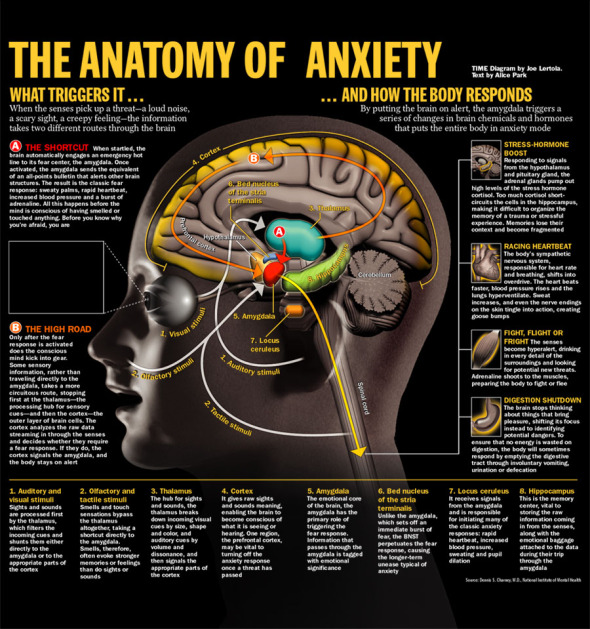
Locus coeruleus
The locus coeruleus is an area located in the pons of the brainstem that is the principal site of the synthesis of the neurotransmitter norepinephrine, which plays an important role in the sympathetic nervous system’s fight-or-flight response to stress. This area receives input from the hypothalamus, amygdala, and raphe nucleus among other regions and projects widely across the brain as well as to the spinal cord.
Raphe nucleus
The raphe nucleus is an area located in the pons of the brainstem that is the principal site of the synthesis of the neurotransmitter serotonin, which plays an important role in mood regulation, particularly when stress is associated with depression and anxiety. Projections extend from this region to widespread areas across the brain, namely the hypothalamus, and are thought to modulate an organism’s circadian rhythm and sensation of pain among other processes.
Spinal cord
The spinal cord plays a critical role in transferring stress response neural impulses from the brain to the rest of the body. In addition to the neuroendocrine blood hormone signaling system initiated by the hypothalamus, the spinal cord communicates with the rest of the body by innervating the peripheral nervous system. Certain nerves that belong to the sympathetic branch of the central nervous system exit the spinal cord and stimulate peripheral nerves, which in turn engage the body’s major organs and muscles in a fight-or-flight manner.
Pituitary gland
The pituitary gland is a small organ that is located at the base of the brain just under the hypothalamus. This gland releases various hormones that play significant roles in regulating homeostasis. During a stress response, the pituitary gland releases hormones into the blood stream, namely adrenocorticotropic hormone, which modulates a heavily regulated stress response system.
Adrenal gland
The adrenal gland is a major organ of the endocrine system that is located directly on top of the kidneys and is chiefly responsible for the synthesis of stress hormones that are released into the blood stream during a stress response. Cortisol is the major stress hormone released by the adrenal gland.
In addition to the locus coeruleus existing as a source of the neurotransmitter norepinephrine within the central nervous system, the adrenal gland can also release norepinephrine during a stress response into the body’s blood stream, at which point norepinephrine acts as a hormone in the endocrine system.
The immune system also plays a role in stress and the early stages of wound healing. It is responsible for preparing tissue for repair and promoting recruitment of certain cells to the wound area. Consistent with the fact that stress alters the production of cytokines, Graham et al. found that chronic stress associated with care giving for a person with Alzheimer’s Disease leads to delayed wound healing. Results indicated that biopsy wounds healed 25% more slowly in the chronically stressed group, or those caring for a person with Alzheimer’s disease.
It’s no surprise that constant stress can make people sick, which researchers have been studying now for some many years.
A study focused on 119 men and women taking care of spouses with dementia. The health of the caregivers was compared with that of 106 people of similar ages not living under the stress of constant care giving.
Blood tests showed that a chemical called Interleukin-6 sharply increased in the blood of the stressed caregivers compared with blood of the others in the test. Previous studies have associated IL-6 with several diseases, including heart disease, arthritis, osteoporosis, type-2 diabetes and certain cancers.
The study also found the increase in IL-6 can linger in caregivers for as long as three years after a caregiver had ceased that role because of the spouse’s death. Of the test group, 78 spouses died during the survey.
People under stress tend to respond by doing things that can increase their levels of IL-6.For example, they may smoke or overeat; smoking raises IL-6 levels, and the chemical is secreted by fat cells. Stressed people also may not get enough exercise or sleep, she added. Exercise reduces IL-6, she said, and normal sleep helps regulate levels of the chemical.
There are many animal pharmaceutical tested synthetic meications that can relieve stress from Amitriptyline, Chlorpromazine, Clonazepam, Clonazepan, Clonidine, Codeine, Valium, Cloziril, and many more all anti-psychotic to (neurological pain relievers such as Amitriptyline as explained) used to treat Neuralgia that is extremely unpleasant and effects one of the most sensitive nerves in the body the “ Trigeminal Nerve” that runs the entire length of your mouth, hence why when you feel tooth ache and it’s on the right hand side you can also feel pain on the left and within one’s ear as the Trigeminal nerve is connected to all nerve endings in the face that shoot pain receptors in many directions making your pain more intense as the infected “tooth” to the “virus or decay” is pressing on this nerve, hence why dentists to neurologists prescribe (nerve relievers to help relax the nerve thus = less pain).
Moving away from the pharmaceutical talk and more on the “natural stress relievers” I have listed as explained above, below for you handpicked stress relievers of which are “botanical aids”. You can purchase these in many local homeopathy natural medicine clinics or have them made up in front of you via tincture and to whatever strength.
Stress headache;
The cayenne pepper—also known as the Guinea spice is a great stress headache reliever “not a cure” and please do note that I use the word constantly “reliever” and not curer. Cayenne or better known in the bionomical language as Capsicum frutescens has been used in many alternative medicine therapies for the (relief) of migraine to stress induced headache that’s caused by mainly the blood vessels in the brain constriction and not allowing the receptors to flow through adequately. Clonidine would normally work here via opening the arteries in the brain as it acts as a vascular dilator. Capsicum frutescens also does the same job though and can be made into a spray or tablet to liquid form although many homoeopathists will tend to opt for the spray as the liquid from the cayenne will travel directly to the point intended this reliving pain over period of time.
Research suggests that capsaicin can also help relieve cluster headaches. In one study, people with cluster headaches rubbed a capsaicin preparation inside and outside their noses on the same side of the head as the headache pain. Within five days, 75 percent reported less pain and fewer headaches. They also reported burning nostrils and runny noses, but these side effects subsided within a week.
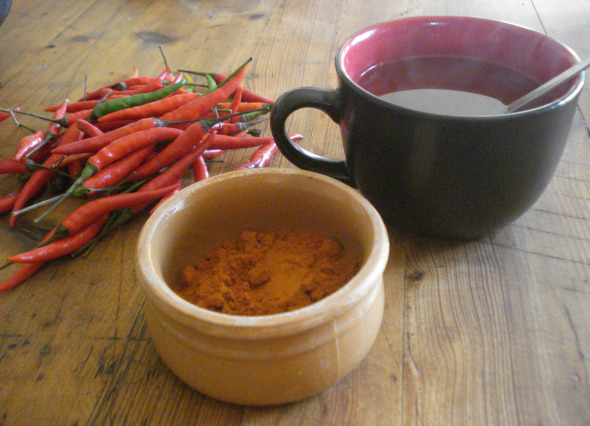
Capsaicin (pictured above)
Back and neck tension;
This is a common form of stress that will affect 7-10 people every week in one way or the other. Pain can range from moderate to severe giving the feeling that your entire body is knotted causing excruciating back, muscle and tendon stress pain.
65 million people in America alone suffer from chronic back pain. Conventional treatment of such injuries usually revolves around strong pain killers, anti-inflammatory drugs, and very often surgery. Unfortunately, it is too common that these treatments do not yield the recovery hoped for.
OK I have two very interesting and powerful alternative medicines here that have been proven to “relieve” and still many people don’t realise the wonders of this botanical alternative medicine[s].
lobelia inflate
Lobelia inflata is a species of Lobelia native to eastern North America, from south eastern Canada south through the eastern United States to Alabama and west to Kansas, Lobelia inflate is not your normal seasonal annum plant but in fact a type (1) perianal. How does it work?
Lobelia is a powerful antispasmodic, indicated by severe spasm. It doesn’t seem to work so well as a preventive, and so would not be an herb I would recommend for regular use, but rather help to resolve spasm when the muscles are seized up and just won’t let go.
To this end, it can be very effective, many people have used it to address grand mal seizures, and said it has worked better than anything they’ve normally used as an alternative to even synthetic pharmaceutical treatment. Lobelia, in large doses, can have an emetic effect – PLEASE NOTE Lobelia can in LARGE dosages induce vomiting, but the tincture taken in small doses is unlikely to produce this result.
I must stress this too and please don’t ignore my professional advice (please). Lobelia like any plant can cause gastrointestinal upsets thus inducing poisoning however (only in large extreme doses), some homoeopathists and herbalists will disagree with me to others, however I am giving you the advice from what I was taught at the Royal Horticultural Society (RHS) to use Lobelia please administering 1-10 drops of lobelia to the effected start low, and work your way up if needed.

Lobelia inflate (pictured above)
kava kava better known as Piper methysticum
The roots of the plant are used to produce a drink with sedative and anaesthetic properties. Kava is consumed throughout the Pacific Ocean cultures of Polynesia, including Hawaii, Vanuatu, Melanesia and some parts of Micronesia. Kava is sedating and is primarily consumed to relax without disrupting mental clarity. Its active ingredients are called kavalactones. A Cochrane Collaboration systematic review of its evidence concluded it was likely to be more effective than placebo at treating short-term social anxiety. Safety concerns have been raised over liver toxicity, largely due to the use of stems and leaves by supplement makers, as opposed to solely the root of the plant as dictated by traditional uses.
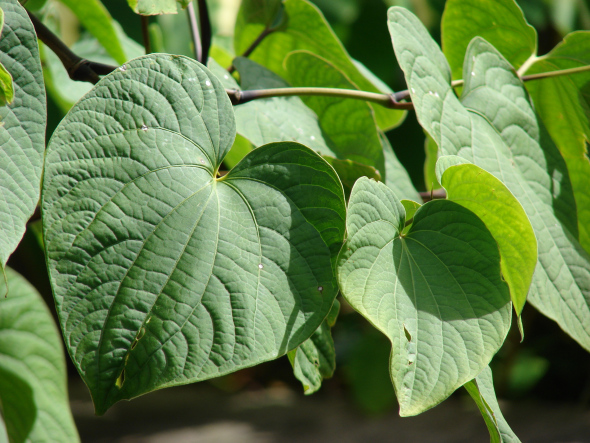
Piper methysticum (pictured above)
Kava Kava though is if used moderately and correctly will not cause liver toxicity such as illicit narcotics or liqueur.
Kava Kava is a very effective remedy for relaxing tension, and it works both on the mind and the muscles. Kava is very often used when people are holding their emotional or mental tension physically, but it can also be useful when the physical tension of an injury is causing a lot of mental anxiety and unrest. While I think Kava poses no problems when taken frequently, it’s an herb I’d restrict to use as needed to deal with the anxiety attending injury, and not the mainstay of treatment. Also, I do think kava works rather nice in larger doses, anywhere from 30 to 90 drops (1 to 3 “squirts” of tincture). Please consult homoeopathists and do not try to prepare yourself unless you’re fully qualified in botanical medicine.
Emotional stress and depressive stress;
Ashwagandha & St Johns Wort
Withania somnifera, also known as ashwagandha, Indian ginseng, poison gooseberry, or winter cherry, is a plant in the Solanaceae or nightshade family. Several other species in the genus Withania are morphologically similar. Yes Nightshades “can be toxic” however only the main species of the (deadly nightshade) Atropa belladonna a completely different species and genus.
Withania somnifera, is a perennial herb found throughout western India. It is also known as the Indian ginseng because of its revitalizing actions. Ashwagandha is a rejuvenating tonic in Ayurveda, and practitioners use the roots to treat general fatigue, nervous exhaustion, insomnia and stress. In their 2000 book “The Herbal Drugstore,” Dr. Linda B. White and medicinal plant expert Dr Steven Foster recommend ashwagandha to enhance your body’s mental and physical performance and its ability to cope with stress. You can use ashwagandha teas, tinctures and capsules, but consult a qualified health care professional for dosage instructions. Do not use ashwagandha if you are pregnant, have stomach ulcers, autoimmune disease, or if you are having surgery with anaesthesia.
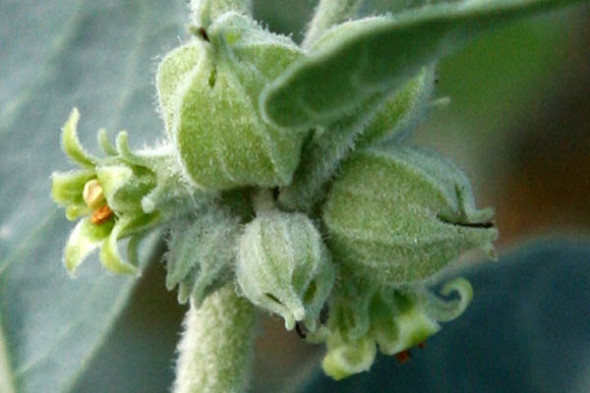
Withania somnifera (pictured above)
You can purchase Ashwagandha here - http://www.google.com/shopping/product/7563134337631719525?q=Ashwagandha&hl=en&rlz=1C1CHMO_enGB520GB520&bav=on.2,or.r_gc.r_pw.r_qf.&bvm=bv.42553238,d.cGE&biw=1517&bih=664&sa=X&ei=4sIdUde_KpDxigLZwIGgBg&ved=0CG4Q8wIwAA
St Johns Wort – Hypericum perfoatum or H. vulgaris is and has been used for some many years across the planet as an emotional stress and depression reliever lifting moods and helping your bodies to battle immune stress and emotions.
Now available on prescription due to cost in herbalist formulation of this amazing plant it can be located in Germany, France, England, and Spain via your local physician. Please note that in some parts of the United Kingdom it’s not available due to funding and what I could locate as a discriminatory post code lottery.
St. John’s wort is most often taken in liquid or pill form. The dried herb may also be used as a tea.
The most common dose used in studies has been 300 mg, three times a day. Preparations in the U.S. have varied amounts of active ingredient in them. So be careful to note how much you’re getting in your tablets.
Please NOTE;
You should be alert for any of the following effects if you are taking St. John’s wort:
- allergic reactions
- fatigue and restlessness with long-term use
- increased blood pressure
- increased sensitivity to the sun — especially if you are fair-skinned and taking large doses
- stomach upsets
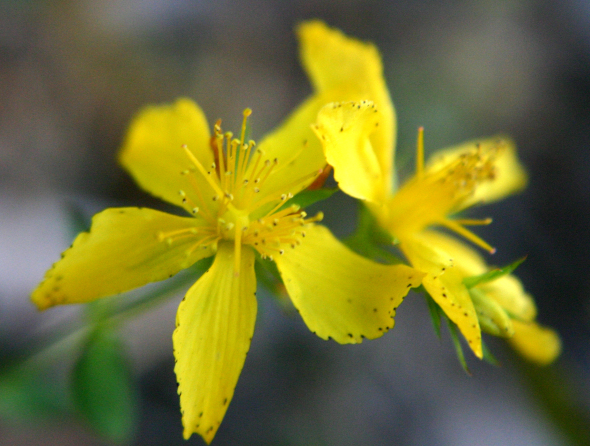
St Johns Wort (pictured above)
Nervous tension/stress/ emotional stress;
Valeriana wallichii known as Tagara
Valeriana wallichii, is a rhizome herb of the genus Valeriana and the family Valerianaceae also called Indian Valerian or Tagar-Ganthoda, not to be confused with Ganthoda or the Long Pepper. It is a herb useful in Ayurvedic medicine used as an analeptic, antispasmodic, carminative, sedative, stimulant, stomachic, and nervine.
A perennial herb rich in volatile oils Ayurvedic practitioners use it to treat emotional stress, nervous tension, insomnia, muscle spasms, headaches and anxiety. The active ingredients are called valepotriates, and they have potent antispasmodic and anti-anxiety action. In her 2009 book, “The Holistic Herbal Directory,” herbalist Penelope Ody says that tagara can also be applied as a cream topically to treat stress-related skin conditions like eczema. Do not combine tagara with other sedatives or antidepressants.
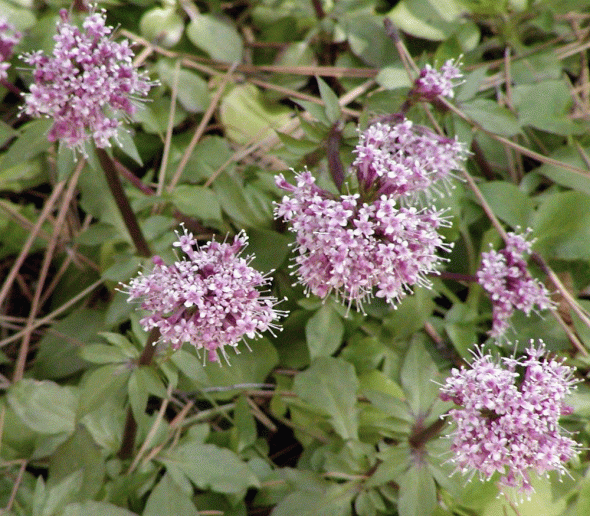
Valeriana wallichii (pictured above)
Please read more here http://www.a2xanxiety.com/reports/anxiety.html?stress?weirdherbscombo?www.livestrong.com
Although I have named only a small handful of the most stressful complaints that can be reduced through using natural herbs there are thousands of botanical species that can be purchased online or at your local herbalist homoeopathist.
Thank you for reading
Dr J C Dimetri V.M.D, B.E.S, Ma, PhD , MEnvSc
Please note in the first video below the speaker quotes “there are no side effects” this is untrue and there are indeed side effects like with synthetic medications. Please always consult your practitioner, herbalists, or homeopathic therapists,
Please note International Animal Rescue Foundation shows BOTH SIDES of every story and wish to explain in great detail our own findings and what knowledge that we are already aware of;



